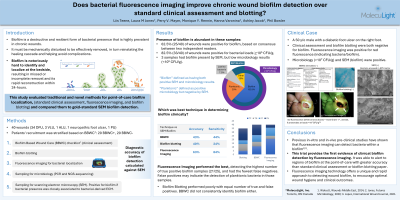Clinical Research
(CR-029) Bacterial fluorescence imaging improves chronic wound biofilm detection over standard clinical assessment and blotting
Thursday, May 16, 2024
7:30 PM - 8:30 PM East Coast USA Time

Perry Mayer, MD; Hanna Varonina, MSc; Ashley Jacob, BSN, RN; Philip Bowler, MPhil, BSc
Introduction: Biofilm is a destructive and resilient form of bacterial burden that is highly prevalent in chronic wounds. Yet, biofilm is notoriously hard to identify and localize at the bedside, resulting in missed or incomplete removal and its rapid reconstruction within 24-hours. This study evaluated promising methods for point-of-care biofilm localization: fluorescence imaging* of wound bacterial loads and biofilm blotting techniques.
Methods: In this clinical trial, 40 chronic wounds underwent the following assessments: (1) Biofilm Based Wound Care (BBWC) checklist for clinical signs of biofilm1, (2) biofilm blotting, (3) fluorescence imaging for localizing bacterial loads*, wound scraping taken for (4) scanning electron microscopy to confirm matrix encased bacteria (biofilm), and (5) PCR and NGS sequencing to determine absolute bacterial load and species present. A combination of SEM and PCR microbiology was used to calculate the diagnostic accuracy measures of the BBWC, biofilm blotting assay and fluorescence imaging.
Results: 20 patients positive and 20 patients negative for the BBWC checklist were recruited. Biofilm (defined as positive microbiology and SEM co-localization of bacteria/ECM) was present in 65% of wounds. Blotting paper technique fared poorly in biofilm detection (37% accuracy and 41% sensitivity), as did clinical assessment (40% accuracy and 42% sensitivity). Fluorescence imaging however performed well (60% accuracy and 81% sensitivity) for biofilm detection. Fluorescence imaging had the highest number of true positives but also the highest number of false positives due to the ability to detect planktonic bacteria as well.
Discussion: This trial provides the first evidence of clinical biofilm detection by fluorescence imaging. It alerted to regions of biofilm at the point-of-care with greater accuracy than standard clinical assessment or biofilm blotting paper. Fluorescence imaging technology offers a unique and rapid approach to detecting wound biofilm, to encourage optimal wound hygiene and clinical outcomes.
Methods: In this clinical trial, 40 chronic wounds underwent the following assessments: (1) Biofilm Based Wound Care (BBWC) checklist for clinical signs of biofilm1, (2) biofilm blotting, (3) fluorescence imaging for localizing bacterial loads*, wound scraping taken for (4) scanning electron microscopy to confirm matrix encased bacteria (biofilm), and (5) PCR and NGS sequencing to determine absolute bacterial load and species present. A combination of SEM and PCR microbiology was used to calculate the diagnostic accuracy measures of the BBWC, biofilm blotting assay and fluorescence imaging.
Results: 20 patients positive and 20 patients negative for the BBWC checklist were recruited. Biofilm (defined as positive microbiology and SEM co-localization of bacteria/ECM) was present in 65% of wounds. Blotting paper technique fared poorly in biofilm detection (37% accuracy and 41% sensitivity), as did clinical assessment (40% accuracy and 42% sensitivity). Fluorescence imaging however performed well (60% accuracy and 81% sensitivity) for biofilm detection. Fluorescence imaging had the highest number of true positives but also the highest number of false positives due to the ability to detect planktonic bacteria as well.
Discussion: This trial provides the first evidence of clinical biofilm detection by fluorescence imaging. It alerted to regions of biofilm at the point-of-care with greater accuracy than standard clinical assessment or biofilm blotting paper. Fluorescence imaging technology offers a unique and rapid approach to detecting wound biofilm, to encourage optimal wound hygiene and clinical outcomes.

.jpeg)